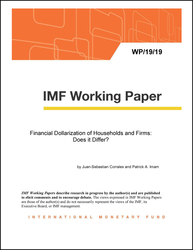
Financial Dollarization of Households and Firms: Does It Differ?
Using a newly complied and extended database from International Financial Statistics, and applying different panel-regression techniques, this paper documents the evolution of households’ and firms’ dollarization over the past decade. We assess the macroeconomic determinants of dollarization for households and firms and explore differences between high and low-income countries. We find that households’ and firms’ dollarization in loans and deposits are weakly explained by the currency substitution model, except in low income countries, where inflation plays a significant role. Instead, market development variables such as financial deepening, access to external debt and FX finance as well as other market considerations are key to explain the dynamics of deposits and loans dollarization, regardless of the level of income.These factors can account for a significant fraction of the dollarization, but using a variance decomposition model, there is evidence that a non-negligible portion has yet to be explained. This suggests that there are key determinants for household and firm dollarization that are not fully captured by traditional macroeconomic explanatory variables.
Publication date: January 2019
ISBN: 9781484393192
$18.00
Add to Cart by clicking price of the language and format you'd like to purchase
Available Languages and Formats
| English |
Prices in red indicate formats that are not yet available but are forthcoming.
Topics covered in this book
This title contains information about the following subjects.
Click on a subject if you would like to see other titles with the same subjects.
Household , Firm , Financial deepening , Monetary Policy (Targets , Instruments , and Effects) , General , International Monetary Arrangements and Institutions
Summary
Copyright © 2010 - 2024
Powered by:
AIDC



